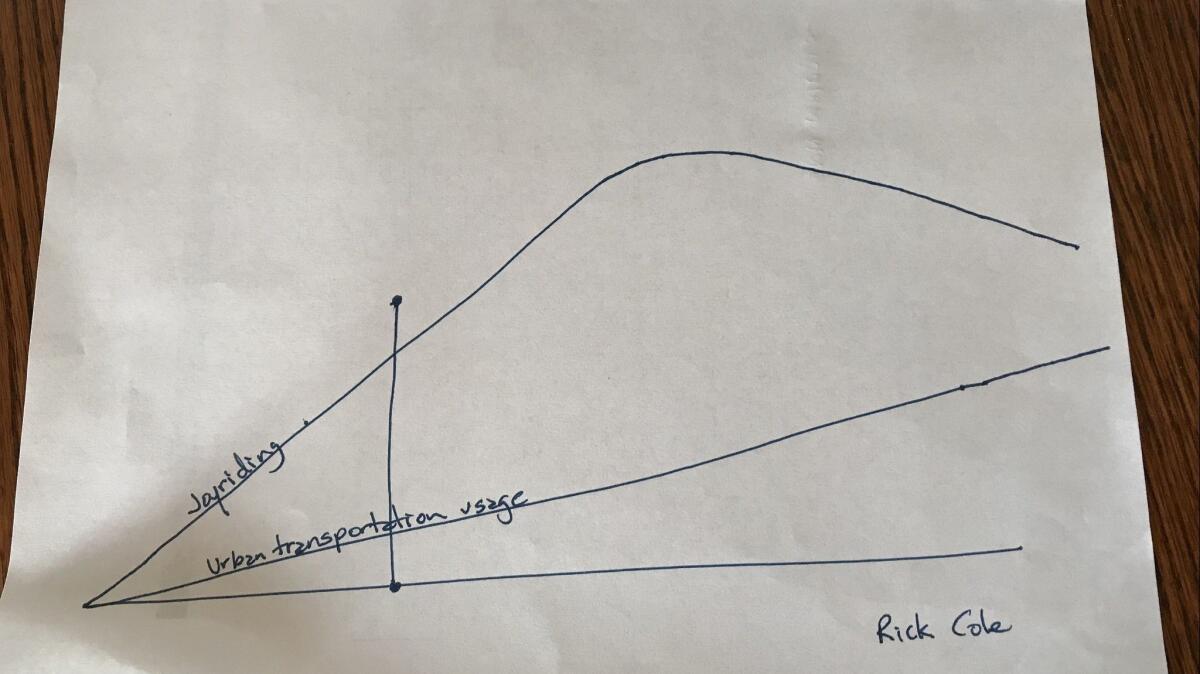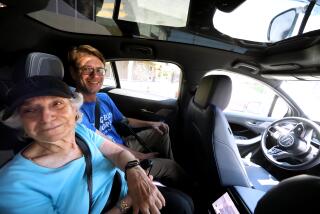Column: Cities crack down on electric scooter scofflaws, while trying to untangle the chaos of a new technology
This is the summer of the electric scooter.
Which is to also say, it is the summer of chaos.
Cities are struggling to regulate the new vehicle, dropped onto sidewalks last fall by tech companies that seemed to have no idea what they were unleashing.
“In some ways, the companies are as much surprised by how this is unfolding as we are,” said Santa Monica City Manager Rick Cole. “How all this was going to work out is not something they thought about deeply.”
Bird, the first company to land in Santa Monica, says its first priority is safety. It has distributed 40,000 free helmets to riders. (Sadly, no one seems to wear them.)
Beverly Hills and West Hollywood have taken a drastic approach; both cities have banned the scooters for now. San Francisco, after some conniption fits, has also banned them as it works out details of a pilot program.
Los Angeles, typically, is dealing with the issue slowly and in a manner that can only be described as confusing. In March, the City Council enacted a moratorium on the scooters while it develops a pilot program, which it is expected to vote on in August.
The city sent an apparently toothless cease-and-desist letter last month to Bird, the biggest company in the app-enabled scooter rental space.
“Please remove any and all vehicles that you have in the City of Los Angeles immediately,” wrote Seleta Reynolds, general manager of the Los Angeles Department of Transportation.
I was told by Bird that the letter was provoked by the arrival of several dozen scooters in the downtown Arts District, which Bird says were promptly removed.
But that’s not what the letter said. And damned if I can find a single person in L.A. city government who can explain to me why the entire city was included in the cease-and-desist letter, whether the order has been lifted, and why no one appears to be enforcing the laws that require scooter riders to wear helmets, be 18 or over, not ride double, and stay off sidewalks.
Reynolds’ spokesman suggested I email Marcel Porras, LADOT’s chief sustainability officer. He never responded. When I later emailed Reynolds, she told me she and Porras were traveling. I asked her if maybe she had access to a telephone. She didn’t respond, but her spokesman got back to me. He was very pleasant and sent me a copy of the proposed pilot program, but was not able to tell me whether the cease-and-desist order had been lifted.
I tried to reach Councilman Mike Bonin, who represents Venice and is chairman of the council’s transportation committee. His spokesman returned my call and said he’d try to arrange a call. I’m still waiting.
::
Santa Monica officials, bless them, were happy to talk about scooters.
The city has neither banned nor ignored them.
Since the fall, the city’s 8.3 square miles have had to absorb the arrival of about 3,000 scooters owned by two companies.
The city has given provisional permits to the start-ups Bird and Lime for the summer. In September, it will launch a 16-month pilot program that will involve just two companies, not necessarily Bird and Lime. About a dozen scooter companies are vying for the honor.
The companies, which charge $1 plus 15 cents per minute per ride, will pay to be part of the program and will be forced to hand over all their usage data to the city, so that scooter usage patterns can be better understood and planned for.
On Tuesday, I spent some time at Santa Monica City Hall with Cole and two of his colleagues, Deputy City Manager Anuj Gupta and chief communications officer Debbie Lee, who described the scooter business model as “brilliant, yet flawed.”
All three were clear-eyed about the problems the scooters have wrought upon an already crowded city. “The model requires them to use public space they don’t have permission to use, and they really don’t have a way of controlling the actions of their riders,” Lee said.

But they know, too, that they cannot turn back the clock, that electric scooters are here to stay.
Companies such as Lime and Bird say the scooters will help ease congestion and pollution by allowing riders to traverse that “last mile between public transit and their jobs.” I have said — and been criticized by scooter fans — that I believe this is wishful thinking. Most people, in my observation, use the scooters for fun, not work. Observation is not the same as data; unfortunately the data have not been released by the scooter companies.
Cole and his colleagues, who have been deeply involved in developing regulations, agree with me.
In fact, when the subject came up, the city manager grabbed a blank sheet of paper and drew a graph, with two lines. One represented “joyriding” and one represented “urban transportation usage.” Cole expects “urban transportation usage” to grow with time, but let’s just say his “joyriding” line soared above it for now.
Indeed, his hand-drawn graph comports with what anyone with two eyes and a brain can deduce: In beach cities like Santa Monica and Venice, where scooter concentration is highest, most riders are on these things for giggles.
Likewise, there is no hard data yet on scooter injuries. But doctors are alarmed by what they are seeing.
“This scooter is no different than a motorcycle scooter,” said Sam Torbati, medical director of the emergency department at Cedars-Sinai Medical Center. “As a physician, I am very concerned about the public safety issues around people who ride without protective gear. I get particularly concerned when I see people with ear buds, carrying things while riding, and riding on the sidewalks.”
His ER, Torbati said, has seen an uptick in injuries associated with scooter crashes — broken arms, legs, shoulders and hips (among older riders, especially), and lots of head injuries.
::
It has fallen on cities and police departments to bear the burden of educating scooter riders.
The Santa Monica Police Department has posted a modestly funny educational video on its Facebook page. The city has also put up signs on the bike path warning scooters to stay off.
I’m going to guess that the two gentle scooter crackdowns executed by Santa Monica police in the last week will be more effective than any signs.
Last Friday, officers stationed themselves on the beachfront bicycle path where Pico Boulevard hits the ocean. They pulled over hundreds of riders — many underage, most without helmets — because motorized vehicles are forbidden on the bike path.
So many riders abandoned their scooters that Cole, who happened to be at a picnic nearby, had to call around for a city truck to take them away.
The next day, scooter riders were back on the bike path in force. And so were the police, who plan to be out every day, stopping, citing and educating riders, Cole reported. “Even our harshest critics have acknowledged that the situation is noticeably improved,” he said.
On Wednesday, officers fanned out along Second Street near the Third Street Promenade. In two hours, said Lee, they stopped 105 scooter riders and issued 59 citations, 42 of which went to helmet-less riders.
I watched some of the stops. Riders, many in shorts and flip-flops, seemed surprised to be nabbed, but were pleasant about it.
Why shouldn’t they be?
It’s not as if they were running late for work.
UPDATES:
1:10 p.m.: This article was updated with additional information about enforcement in Santa Monica.
This article was originally published at 3 a.m.



